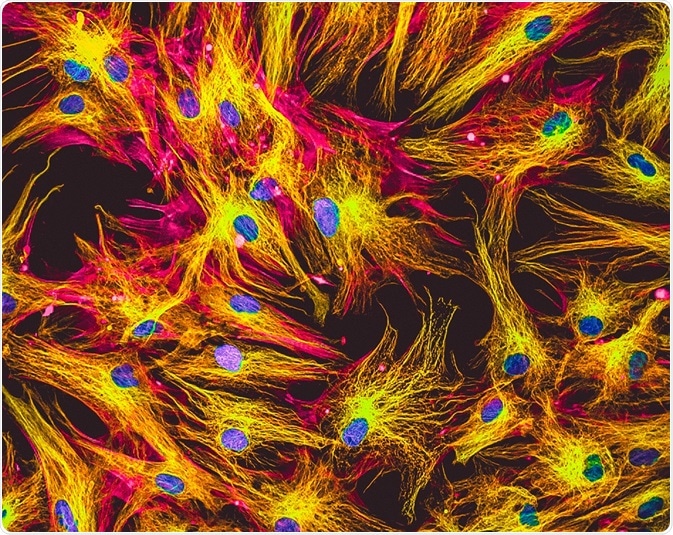
Cell Metabolism Assays
Cell metabolism is essential for normal physiology in all organisms. Many different assays are used to detect and measure cellular metabolism, depending on the metabolite being investigated.
 Image Credit: Vshivkova / Shutterstock
Image Credit: Vshivkova / ShutterstockGlucose detection
2-NBDG (2-(N-(7-Nitrobenz-2-oxa-1,3-diazol-4-yl)Amino)-2-Deoxyglucose) Assay
Measuring the glucose uptake inside cells is important to evaluate several biological processes and their disease states. For example, measuring glucose uptake during diabetes is critical. 2-NBDG is a fluorescent protein and a glucose analogue.
In this assay, 2-NBDG is directly incubated with the cells. After some time, the fluorescence intensity inside the cells is measured using flow cytometry. This assay is also used to measure the changes in glucose uptake in the presence of different anti-diabetic drugs.
Glucose oxidase assay
10-acetyl-3,7-dihydroxyphenoxazine is a peroxidase substrate. As both glucose oxidase and peroxidase reactions are coupled, this assay can be used to measure glucose activity and glucose levels inside cells, food, and bodily fluids.
In this assay, glucose oxidase reacts with glucose to generate hydrogen peroxide. Hydrogen peroxide then reacts with a reagent (Ampex Red) to generate a red fluorescent protein called resorufin. The levels of this red fluorescent protein can then be used to analyse the levels of glucose.
Cholesterol
Cholesterol hydrogen-peroxide assay
Cholesterol exists inside cells as free cholesterol and cholesterol esters. This assay uses a compound which reacts with the H2O2 produced by oxidation of cholesterol and produces a fluorescent compound.
This assay can measure both free cholesterol and cholesterol esters and is highly sensitive; being able to detect even very small quantities of cholesterol (200 nm). It has minimal autoflourescence and the fluorescence can be measured at multiple time points.
Phosphatidylcholine-Specific Phospholipase C (PC-PLC) assay
In this assay, 10-acetyl-3,7-dihydroxyphenoxazine is used as a probe. PC-PLC can convert phosphatidylcholine to phosphocholine and diacylglycerol.
Alkaline phosphatase then converts phophorylcholine to choline which is then oxidized to form hydrogen peroxide. This hydrogen peroxide can then react with 10-acetyl-3,7-dihydroxyphenoxazine to form a red fluorescent protein called resorufin.
The fluorescent signal can be detected using microcopy to analyse the phospholipase-C activity. The PC-PLC assay is a sensitive assay with minimal autoflourescence.
ATP detection
This assay uses recombinant firefly luciferase and its substrate (D-luciferin) to determine the ATP levels inside cells. Luciferase produces light in the presence of ATP. This assay is very sensitive and can detect 0.1 picomole of pre-existing ATP or newly formed ATP.
This assay can be used to detect ATP changes during different enzymatic reactions and bacterial contamination in blood, milk, urine, and soil. It can also be used to analyse cell proliferation, cytotoxicity, effects of antibiotics and anti-cancer drugs.
Galactose-galactose oxidase assay
This assay is used to detect the levels of galactose inside cells. In this assay, galactose oxidase is used to catalyse galactose to generate hydrogen peroxide.
Hydrogen peroxide then reacts with Ampex Red compound to generate a red florescent protein called resorufin.The fluorescence of resorufin are measured and used as an indicator of the levels of galactose in the sample.
As well as cell metabolism, the galactose-galactose oxidase assay can be used to study cell signaling, neurobiology, inflammations, immune function. The fluorescence generated by resorufin is stable to at least 3 hours.
Hydrogen peroxide assay
Tye hydrogen peroxide assay is a sensitive method to detect the levels of hydrogen peroxide inside cells. This assay uses a reagent Ampex Red which reacts with hydrogen peroxide to generate a red fluorescent protein called resorufin.
The levels of resorufin can be used as an indicator to measure the H2O2 levels. This is a very sensitive assay which can measure even 10 picomoles of H2O2.
Reviewed by Hannah Simmons, BSc
Sources:
- A cell-based high-throughput assay system reveals modulation of oxidative and nonoxidative glucose metabolism due to commonly used organic solvents.
- A method of direct measurement for the enzymatic determination of cholesteryl esters.
- Galactose oxidase action on galactose containing glycolipids - a fluorescence method.
Further Reading
Last Updated: Aug 1, 2018






















.png)











No hay comentarios:
Publicar un comentario